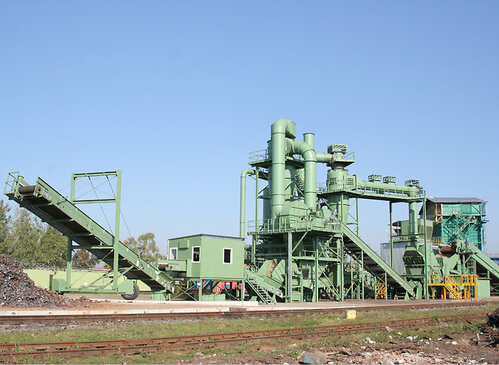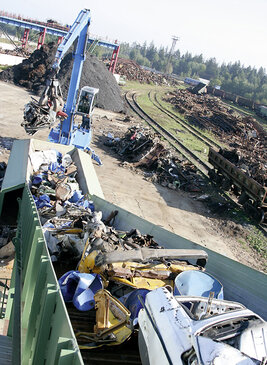Contact
You have any questions?
Or want us to call you?
By using our online form your questions and requests will be forwarded to the responsible contact person.
...to the form
Adapted shredder plant breaks new ground in Belarus
In Belarus, scrap treatment sits in the public sector, with state-controlled companies usually operating several collection yards and co-ordinating supply to steel producers. Until recently, there was neither scrap collection according to product type nor sorting of potential recyclables. However, the introduction of an adapted shredder from Germany marks the start of a new era.
Belarus was previously one of the most developed republics within the former Soviet Union. In addition to a strong textile and wood-working tradition, the country’s engineering sector has experienced solid growth over the last four decades, with the result that steel production and improved scrap processing have become extremely important.
Although Belarus faces enormous environmental, political and economic problems, the country’s vision often astounds observers. Take the case of the shredder plant supplied by Venti Oelde, the German engineering and technology specialist which has developed an international reputation for its air handling and processing equipment: developed in response to a public tender, the plant takes account of current European safety standards and also of remarkably forward-looking goals.
A number of challenges
The project presented Venti Oelde with a number of challenges, including: the language barrier; differences in levels of training; electrical and electronic shortcomings; and the need to introduce Cyrillic lettering into the visualisation software, plant labelling, systems documentation and diagnostics routines. Another major factor was the harsh Belarus winter with its extremely low temperatures.
Under the supervision of Venti Oelde personnel, local teams installed the modules and components at a collection centre near the country’s capital Minsk. The project became so high profile that Belarussian television reported regularly on its progress and outlined to viewers the benefits of selective pre-separation of materials for recycling.
The main components of the installation include: a 2000 HP Hoffmann shredder with apron feeder and outfeed conveyor; a shredder dust collection system with water circulation; a ferrous line with cascade separator and magnetic separation; conveyor technology for non-ferrous materials and waste; and control and monitoring instruments. Training courses were provided for the shredder operators and also for maintenance personnel.
Customised shredder technology
Within the plant, scrap is transferred onto the speed-controlled infeed conveyor using, for example, bucket shovels and grabs. Material then passes via a chute to two feed rollers which ensure positive feed to the shredder. By lowering and raising the overhead roller in a similar way to a car body press, material is compressed prior to entering the next process stage where knives, suspended loosely from the rotor, tear material against an anvil edge.
The volume of scrap inside the shredder is monitored in the control cabin: if it is too high, the infeed conveyor and rollers can be slowed or stopped altogether. Unshreddables are ejected from the plant through a door and carried away on a vibrating conveyor beneath the shredder.
Tackling the explosion risk
When in operation the shredder generates a considerable volume of integral air, which must be captured and exhausted from the top section of the shredder, because otherwise the air with fine dust would emit to the atmosphere without being dedusted. To protect the dedusting system against explosion, the ducting between the top section of the shredder and the cyclone is pressure-shock-resistant and fitted with explosion vents. In the event of an explosion, these vents open in response to the increase in pressure and thereby protect the entire system.
Coarse dust particles are removed from the air-stream in the pressure-shock-resistant cyclone separator and discharged through the calming hopper and rotary airlock. The pre-cleaned air then passes into a washer where the air/dust mixture is wetted by a venturi nozzle to assist the de-dusting process. Tangential entry into the washer permits dust/water drops to be released from this wetted dust/air-stream. The rising air-stream is cleaned further in the upper area of the washer system where the remaining water particles are removed by a droplet eliminator. Finally, a high-efficiency centrifugal fan blows clean air into the atmosphere. Not only the ducting, but also the washer upper section and high-efficiency centrifugal fan are pressure-shock-resistant; they are also fitted with vents to protect the system in the case of an explosion. Circulating water used in the washer system is cleaned in a rotary drum and sedimentation tank, with scrapers removing slurry floating in the settling tank.
Improving separation quality
Shredded product is transferred to the air separator and fed into the separating channel. The air-stream captures fines/fluff and conveys them via a connecting duct to the cyclone separator. Heavy metals and non-metal products fall down through the cascade, thus further loosening and dispersing the material to improve separation quality. Replaceable wear plates protect the surfaces inside the separator.
The light fraction is removed from the air-stream in the cyclone separator before the air passes to the circulating fan. A frequency converter controls the air volume and, therefore, the separation velocity. To ensure that dust clouds are not produced in the air separator, a certain amount of so-called ‘aspiration’ air is carried downstream of the circulating fan and cleaned in the washer.
Heavy material exiting the cascade is transferred to a magnetic drum via a vibratory conveyor. This lifts ferrous scrap onto a picking belt while non-magnetic material falls onto a discharge belt. Iron and copper compounds - as well as any remaining impurities - are then hand-picked from the product flow. At the end of the hand-picking belt, the mass flow of the ferrous scrap is measured using a belt-mounted weighing machine. These data are then displayed and recorded in the operator’s control cabin.
The final ferrous scrap product is either stockpiled or loaded straight into containers/railway wagons using a swivel-mounted conveyor.
Non-ferrous materials and waste
Any heavy, non-magnetic material which has not been captured by the magnetic drum is carried via a belt conveyor to waiting containers. The remaining ferro-magnetic substances are removed from the product flow by an over-belt magnetic separator. The operator will decide whether to install additional equipment for the further processing of non-ferrous materials and waste.
Residual material - the shredder light fraction - is discharged through a rotary air-lock onto a belt conveyor which also collects solid residues from the water treatment slurry dredger. Remaining ferrous components are then removed from these residual substances using an over-belt magnetic separator and ejected into a container.
Modem link to the manufacturer
The plant is operated and monitored using ‘bus’ technology such that all equipment is linked to the controller via a single cable. Data flow is achieved via serial transmission to the controller for decryption; expansion or modifications can be carried out cheaply and quickly on individual plant components. Everything can be controlled via a central unit connected to the public telephone network via a modem. The tele-service offered by Venti means any malfunction can be analysed within minutes at the manufacturer’s service centre in Oelde, Germany.
Indeed, one of the operator’s main concerns had been that, following commissioning of the plant, the manufacturer would remain at arm’s length in Germany. In the event, the operators can call on a competent service partner in Belarus while the data tele-transmission capability provided by Venti ensures the customer will enjoy excellent after-sales service.




